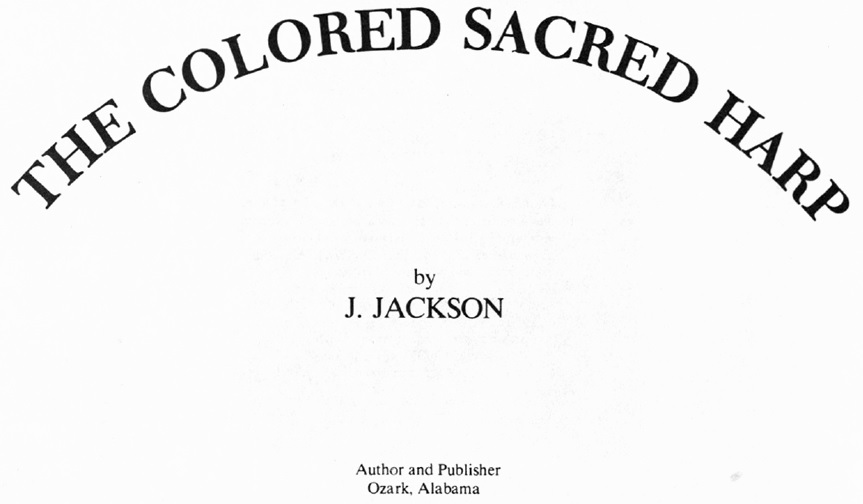



The Colored Sacred Harp was published in 1934 by Judge Jackson (1883-1958) of Ozark, Alabama. This book provided the means for talented composers within the Black Sacred Harp community of Southeast Alabama to have their works published. It is a small, thin book of 77 songs. It is used as a supplement at the Cooper Book singings hosted by the African Americans of Southeast Alabama and Northwest Florida. Jackson wanted to work on this book in the hopes that it would encourage other African Americans in the area to have more of an interest to the singing.
Not only did Jackson live in Ozark, Alabama, so did W. M. Cooper, B. F. Faust, and R. M. Davis who were composers and on the revision committee for the Cooper Edition of The Sacred Harp. In a nearby town lived B. P. Poyner, who was also on the revision committee. These individuals were friends with Jackson. Cooper and Poyner taught many singing schools among the African Americans from their community. One older African American singer commented that the whites and the African Americans would visit each other's singings during this time.
Jackson may have submitted some of his own compositions for the 1927 Revision of the Cooper Book. It is not known if Jackson's submissions were rejected due to lack of quality, or even if he did make any submissions. Either way, Jackson was motivated to publish an independent book. Jackson took his manuscript to the 1927 "white committee" of the Cooper Book to secure their approval. One of the white singers, B. F. Faust of Ozark, Alabama, composed and contributed a song for Jackson's book: "Eternal Truth thy Word."
Each song in The Colored Sacred Harp is an original composition and is not in any other book. The only exception is "My Mother's Gone," which was later added to the 1992 Revision of the Cooper Book.
One memorable song in the book is "Florida Storm," which tells about the Great Miami Hurricane that hit Miami, Florida, on September 18, 1926. This was a category four hurricane that left 372 deaths, over 6,000 injuries, and an estimated $105 million in property damage. The song depicts some of the agony that the people in Miami went through on that day: the injuries, the damage caused by the storm, and the anguish of those who suffered through the storm. The first verse begins, "September Eighteenth, Nineteen Hundred and Twenty-six, The people cried mercy in the storm," while the chorus would end, "The colored and the white stay'd awake all the night, Crying Lord have mercy in the storm."
When The Colored Sacred Harp was first published, it was a paper-back book. With the help of Federal and State grants, the book was reprinted as a hard-bound book in 1973. The book was revised by Jackson's son, Japheth Jackson, in 1983 and again in 1992. The only changes that were made in these two revisions were adding a rudiment section and an autobiography of Judge Jackson. The music did not change.
Sources:
Boyd, Joe Dan. Judge Jackson and the Colored Sacred Harp. (Montgomery, AL: Alabama Folklife Association, 2002).
Cobb, Buell E. The Sacred Harp: A Tradition and Its Music. (Athens, GA: University of Georgia Press, 1987).
Jackson, Judge. The Colored Sacred Harp. (Ozark, AL: H. J. Jackson, 1983).
Jackson, Judge. The Colored Sacred Harp. (Ozark, AL: H. J. Jackson, 1992).
McCorquodale, Amanda. "Great Miami Hurricane of 1926: 87 Year Anniversary (Photos)," The Huffington Post (18 September 2013), <http://www.huffingtonpost.com/2013/09/18/miami-hurricane-1926_n_3948148.html> (8 August 2014).